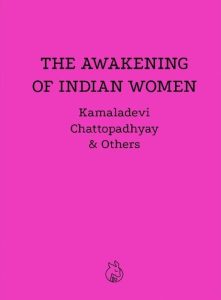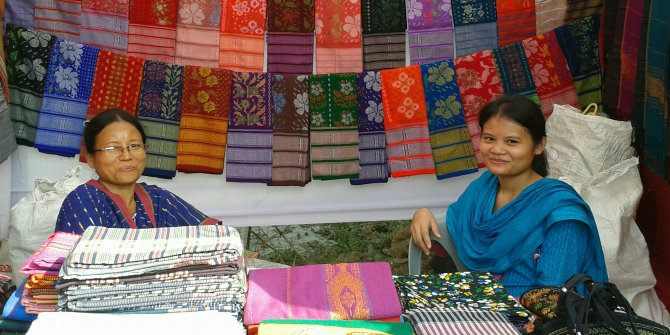First published in 1939, The Awakening of Indian Women by Kamaladevi Chattopadhyay and other activists is a ground-breaking account of the Indian feminist movement in the early decades of the twentieth century. In an edited excerpt from her introduction to Lurid’s new edition, Sumita Mukherjee situates this revolutionary text within India’s anti-colonial struggle and the global women’s movement, and pays tribute to Kamaladevi’s lifelong activism.
On Wednesday 13 September 2023 LSE will host The awakening of Indian women, an online public event to celebrate the book’s republication, with Sumita Mukherjee joining as a panellist. Find out more and register to attend here.
The Awakening of Indian Women. Kamaladevi Chattopadhyay & others. Lurid Editions. 2023.
 Kamaladevi Chattopadhyay, born in 1903 in Mangalore, a port city on the west coast in South India, was a leading member of the Indian women’s movement during the height of the anticolonial struggle in the interwar period. She was one of the co-founders of the All-Indian Women’s Conference, the leading women’s rights group in India. She was also one of the early members of the Congress Socialist Party. Known by her first name, Kamaladevi was keen to put together a book that would inform international readers about the vibrancy of radical activism on the Indian subcontinent and inspire support for the ongoing anticolonial struggle. Her key argument was that Indian women could only be truly emancipated with radical social change and the dismantling of colonialism.
Kamaladevi Chattopadhyay, born in 1903 in Mangalore, a port city on the west coast in South India, was a leading member of the Indian women’s movement during the height of the anticolonial struggle in the interwar period. She was one of the co-founders of the All-Indian Women’s Conference, the leading women’s rights group in India. She was also one of the early members of the Congress Socialist Party. Known by her first name, Kamaladevi was keen to put together a book that would inform international readers about the vibrancy of radical activism on the Indian subcontinent and inspire support for the ongoing anticolonial struggle. Her key argument was that Indian women could only be truly emancipated with radical social change and the dismantling of colonialism.
Kamaladevi was keen to put together a book that would inform international readers about the vibrancy of radical activism on the Indian subcontinent and inspire support for the ongoing anticolonial struggle
By 1923, Kamaladevi was fully engaged with the nationalist struggle as a member of the Indian National Congress and with the women’s movement. With Irish suffragist, theosophist and feminist Margaret Cousins, and other leading Indian feminists such as Naidu, Sarala Ray, Muthulakshmi Reddy and Rajkumari Amrit Kaur, she founded the All-India Women’s Conference (AIWC) in 1927.
In the 1926 General Election in India, Kamaladevi contested for a seat in the Madras Legislative Assembly. Although Mary Poonen Lukhose had been the first woman appointed as a member of an Indian legislative body in 1925 in Travancore, Kamaladevi was the first women to contest any seats in the Indian Legislatures. (She lost by about 55 votes, although only 4.62% of the total votes were cast by women.) In 1929, she attended the International Women’s Suffrage Alliance Conference in Berlin. Incensed that the Indian delegation would have to stand under a British flag, she and her fellow Indians cut up fabric from their saris to create a tricolour flag that was flown beside the others.
Awakening was published in 1939 at the height of Kamaladevi’s engagement with Indian feminism and nationalist circles, and of Gandhi’s civil disobedience movement
Awakening was published in 1939 at the height of Kamaladevi’s engagement with Indian feminism and nationalist circles, and of Gandhi’s civil disobedience movement. It brings together a range of prominent women to offer a captivating history of the Indian women’s movement in the early twentieth century. Its attacks on imperialism and the patriarchy highlight the ways in which feminist thought was not unique or original to the west. Building upon her own education in sociology, social welfare and social research, Kamaladevi is clearly influenced by Marxist critiques of imperialism and offers her feminist-Marxist understanding of Indian society, arguing that India’s economic and social development had been hindered by the British.
Kamaladevi’s writing contains simplifications and generalisations. There are also at times utopian understandings of Indian society at large or in the pre-colonial period, with perhaps not enough emphasis on the issues of caste or sexuality. For example, Kamaladevi suggests that prostitution did not exist before capitalism, and that the system of purdah was not followed by Hindus, both of which do not accurately reflect the complexities of Indian society and the syncretisation of social practices within the region. However, she is clear in her analysis of how western imperialism did not emancipate colonised women despite the rhetoric of the civilising mission.
Kamaladevi presents vital discussions around the position of Indian women as they related to issues such as literacy, property laws, child marriage and the zenana (the area of a Hindu or Muslim house reserved for the women)
Kamaladevi presents vital discussions around the position of Indian women as they related to issues such as literacy, property laws, child marriage and the zenana (the area of a Hindu or Muslim house reserved for the women). Awakening also offers useful contemporary insight into the major colonial and anticolonial activities in the subcontinent, especially of the 1920s and 1930s. Key to understanding much of the inequities of British imperialism lie in the laws and political structures they were responsible for implementing. These included the ways in which British colonial rule propped up existing property laws that disenfranchised women and the zamindari (landlord system) that perpetuated feudal land structures.
The book highlights the position and power of social reform movements, such as the 1929 Child Marriage Restraint Act. This was the culmination of work led by Harbilas Sarda and the All-India Age of Consent Committee that set the minimum age for child marriage at fourteen for all girls and eighteen for all boys in British India. This is just one example of the solidarity of Indian women with the nationalist movement, who often put the claims of anticolonialism first, as they recognised the need to rid themselves of the shackles of imperial patriarchies before tackling the insidious patriarchies within domestic India. The solidarity extended to Kamaladevi’s including essays by other lesser-known Indian women: Sakuntala Thampi, Maharani Indirabai Holkar of Indore, Shyam Kumari Nehru and Jayashriben Raiji. They cover important issues such as crafts, cottage industries, legal disabilities and the position of women in the household.
After the independence of India and Pakistan in 1947 […] she became more involved in the arts and crafts and theatre movements, placing cultural production at the heart of India’s economic revival
Kamaladevi was keen to produce a collection of essays that would counter the lack of information produced and published by Indian women at the time. Though willing to critique Gandhi, the Congress party and the nationalist movement more largely – and especially attacking some of the conservative forces within Congress that limited its economic radicalism and limited women’s participation – her critiques did not extend to the ways Gandhi encouraged a separation of duties for women and men, both within the home and within the nationalist movement. Nor did she deter Gandhi for how he discouraged women’s economic independence. However, Kamaladevi’s critiques of imperialism and patriarchal forces sustained her following the publication of Awakening, and after the independence of India and Pakistan in 1947, when she became more involved in the arts and crafts and theatre movements, placing cultural production at the heart of India’s economic revival. Kamaladevi’s vision of placing arts and crafts and indigenous production as key to autonomous growth emerges in the chapters of Awakening and was to become central to her outlook after Indian independence. Kamaladevi was All-India Women’s Conference president from 1944-5. In 1953, she was a member of the Commission on Human Rights. After 1947, Kamaladevi became involved in the All-Indian Handicrafts Board and was an active promotor of handicrafts. She also launched the Indian National Theatre. She died in 1988 and continues to be celebrated as a leading nationalist and feminist within India today.
Kamaladevi was keen to make people aware of the lively, engaged, and independent nature of the Indian women’s movement, and to ensure that critiques of colonialism were being heard and understood around the world
Speaking from India to international audiences, Kamaladevi was keen to make people aware of the lively, engaged, and independent nature of the Indian women’s movement, and to ensure that critiques of colonialism were being heard and understood around the world. She wanted to educate and counter the prejudices about Indian women that she had encountered in her own travels and to highlight the injustices of British imperialism and forge new feminist solidarities. In 1939 Kamaladevi visited Egypt and argued for closer cooperation between Indian and Egyptian feminists. Kamaladevi’s publications were also a counter to the co-option of the Indian women’s movement.
She wanted to highlight the injustices of British imperialism and to forge new feminist solidarities
Many of her British contemporaries engaged in the international women’s movement were keen proponents of the British Empire and failed to see how their calls for women’s equality contradicted with their imperialist stances. During her European tour to publicise Awakening from 1939 to 1941, Kamaladevi reached out to African Americans, including the National Association for the Advancement of Colored People (NAACP), keen to build up anti-racist and anti- imperial solidarities. Awakening was not widely reviewed beyond India despite the publishers’ and Kamaladevi’s intentions.Its re-publication by Lurid Editions in 2023 hopefully brings Kamaladevi’s work to the attention of audiences she was always so keen to reach.
This book extract gives the views of the author, and not the position of the LSE Review of Books blog, nor of the London School of Economics and Political Science.
The Awakening of Indian Women will be available from Lurid Editions from 14 September; you can pre-order it here. This edited extract from the introduction by Sumita Mukherjee is copyrighted to Lurid Editions and is reproduced here with their permission.
Main Image credit: Photograph of Kamaladevi Chattopadhyay by an unknown author via Wikimedia Commons.







